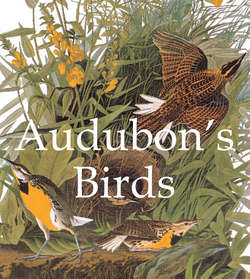Читать книгу Audubon's Birds - John James Audubon - Страница 4
Preface
Оглавление“Audubon could have been anything: a great philosopher, a great orator, a great poet, a great statesman, a Jean-Jacques Rousseau, a Montesquieu, a Chateaubriand. However, he was unable to be other than a naturalist, painter, and American ornithologist, a Buffon of the Northern States, but a Buffon of genius, spending his life in virgin forests and writing with the enthusiasm of solitude a few pages of the great animal epic of creation.” (Lamartine, Cours familier de littérature, Paris, 1865).
Portrait of John James Audubon
John Syme, 1826
The White House Collection, Washington D.C.
When John James Audubon decided after his meeting with Alexander Wilson in 1810 to paint and describe all the birds of North America, surely he never imagined that it would entail a lifetime of travels, scientific as well as artistic discoveries, and a pursuit of quality to the final proof of the published prints. That is the personality of this French American ornithologist, unique in his field, who succeeded in describing and illustrating all birds of the North American continent, there where his predecessors were confined to the former French and British colonies to the explored territories.
Greater Flamingo
Phoenicopterus ruber
Plate 431
Ducks
Yet, his legacy does not stop there. The originality of his illustrations marks a turning point in the history of representing nature. Audubon’s depictions are life size, thus requiring him to multiply the number of birds appearing on the same plate, or bend the necks of others as with the Greater Flamingo. In addition, he portrays them in a natural setting, far from scientific exhibits of stuffed specimens displayed on perches. Consequently, his birds live, hunt, hatch, peck, fly, and soar.
Barn Swallow
Hirundo rustica
Plate 173
Swallows
This humanity in representing our environment, in the tradition of Enlightenment thinkers, immediately received its deserved respect in Europe from 1828 onward.
Audubon’s impressive oeuvre is composed of two parts: 435 plates, drawn between 1808 and 1838, and 435 notes, Ornithological Biographies, later written to accompany the previously published plates. Here again, Audubon exhibited a passion for perfection which pushed him to supervise the colouring and printing of each of the 87,000 requisite plates for the 200 copies of this work.
Artic Tern
Sterna paradisaea
Plate 250
Gulls
Finally, the text, including a description of the family, followed by the genus, and finally the species of each bird, is as much a source of scientific information as artistic. Once again, Audubon let the Romantic spirit of his time shine through his work whose harmony and quality are still, if not more than ever, recognised today.
In the following edition, you will find 120 of Audubon’s 435 plates in addition to descriptions of the forty five bird families to which he dedicated a lifetime identifying. Therefore, we invite you to discover, thanks to this unprecedented approach, the vanishing universe of this nature lover.
Rose-breasted Grosbeak
Pheucticus ludovicianus
Plate 127
Finches
